初中英语语法八大时态总结教学文案
初中英语语法八大时态总结(完整版)
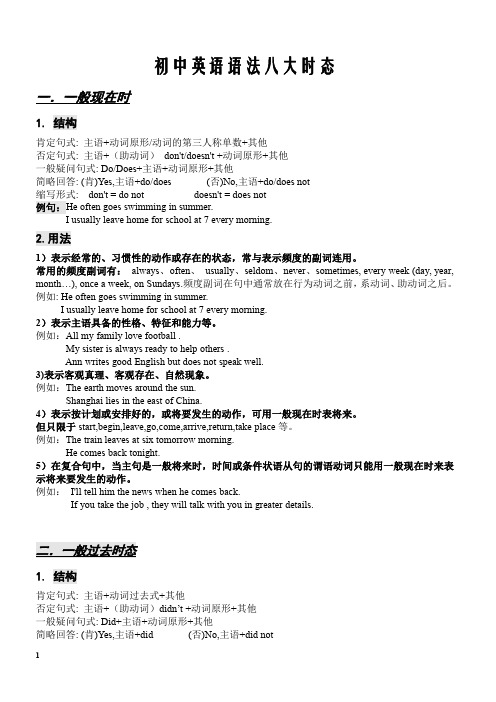
初中英语语法八大时态
一.一般现在时
1.结构
肯定句式:主语+动词原形/动词的第三人称单数+其他
否定句式:主语+(助动词)don't/doesn't+动词原形+其他
一般疑问句式:Do/Does+主语+动词原形+其他
简略回答:(肯)Yes,主语+do/does(否)No,主语+do/does not
缩写形式:don't=do not doesn't=does not
例句:He often goes swimming in summer.
I usually leave home for school at7every morning.
2.用法
1)表示经常的、习惯性的动作或存在的状态,常与表示频度的副词连用。
常用的频度副词有:always、often、usually、seldom、never、sometimes,every week(day,year, month…),once a week,on Sundays.频度副词在句中通常放在行为动词之前,系动词、助动词之后。例如:He often goes swimming in summer.
I usually leave home for school at7every morning.
2)表示主语具备的性格、特征和能力等。
例如:All my family love football.
My sister is always ready to help others.
Ann writes good English but does not speak well.
初中英语语法八大时态总结推荐文档
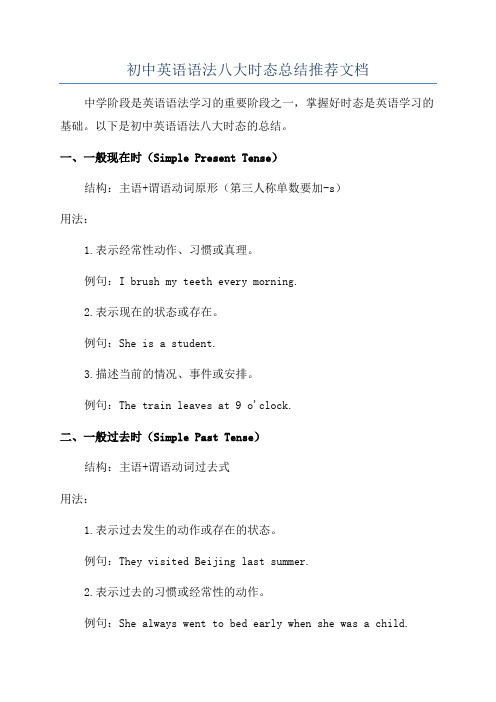
初中英语语法八大时态总结推荐文档中学阶段是英语语法学习的重要阶段之一,掌握好时态是英语学习的基础。以下是初中英语语法八大时态的总结。
一、一般现在时(Simple Present Tense)
结构:主语+谓语动词原形(第三人称单数要加-s)
用法:
1.表示经常性动作、习惯或真理。
例句:I brush my teeth every morning.
2.表示现在的状态或存在。
例句:She is a student.
3.描述当前的情况、事件或安排。
例句:The train leaves at 9 o'clock.
二、一般过去时(Simple Past Tense)
结构:主语+谓语动词过去式
用法:
1.表示过去发生的动作或存在的状态。
例句:They visited Beijing last summer.
2.表示过去的习惯或经常性的动作。
例句:She always went to bed early when she was a child.
三、一般将来时(Simple Future Tense)
结构:主语+will+谓语动词原形
用法:
1.表示将来会发生的动作或事件。
例句:I will study abroad next year.
2.表示打算、意愿、请求、允诺等。
例句:You will help me, won't you?
四、现在进行时(Present Continuous Tense)
结构:主语+be(am/is/are)+动词-ing
用法:
1.表示现在正在进行的动作。
例句:He is reading a book now.
初中英语语法八大时态总结(完整版)
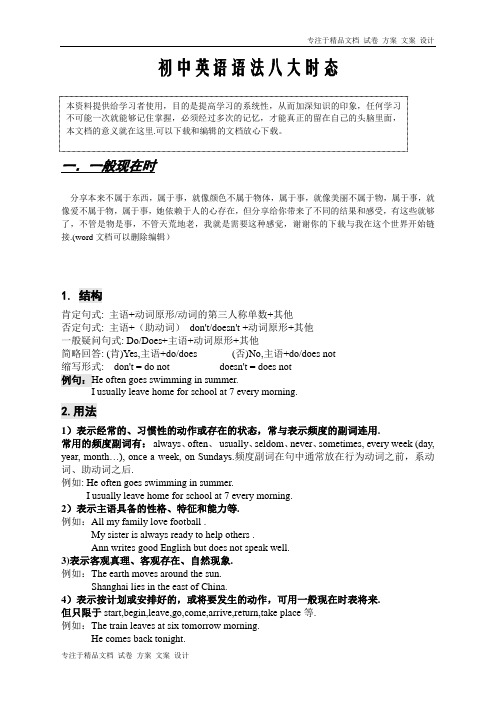
初中英语语法八大时态
一.一般现在时
分享本来不属于东西,属于事,就像颜色不属于物体,属于事,就像美丽不属于物,属于事,就像爱不属于物,属于事,她依赖于人的心存在,但分享给你带来了不同的结果和感受,有这些就够了,不管是物是事,不管天荒地老,我就是需要这种感觉,谢谢你的下载与我在这个世界开始链接.(word文档可以删除编辑)
1.结构
肯定句式: 主语+动词原形/动词的第三人称单数+其他
否定句式: 主语+(助动词)don't/doesn't +动词原形+其他
一般疑问句式: Do/Does+主语+动词原形+其他
简略回答: (肯)Yes,主语+do/does (否)No,主语+do/does not
缩写形式: don't = do not doesn't = does not
例句:He often goes swimming in summer.
I usually leave home for school at 7 every morning.
2.用法
1)表示经常的、习惯性的动作或存在的状态,常与表示频度的副词连用.
常用的频度副词有:always、often、usually、seldom、never、sometimes, every week (day, year, month…), once a week, on Sundays.频度副词在句中通常放在行为动词之前,系动词、助动词之后.
例如: He often goes swimming in summer.
I usually leave home for school at 7 every morning.
初中英语语法八大时态总结(完整版)
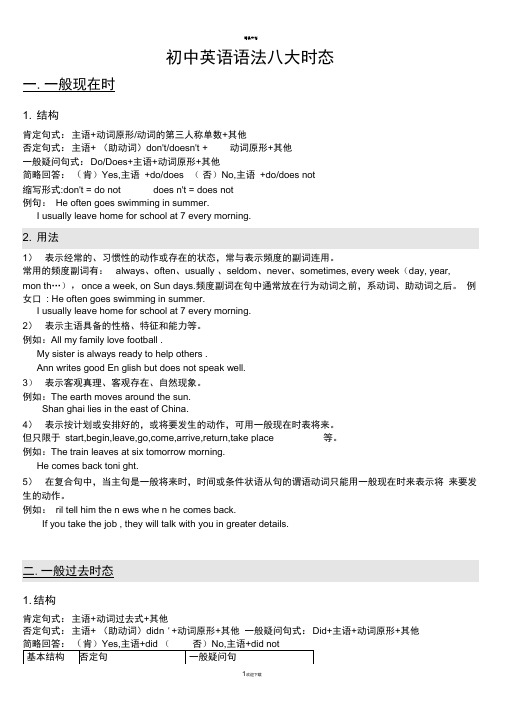
初中英语语法八大时态
一.一般现在时
1. 结构
肯定句式:主语+动词原形/动词的第三人称单数+其他
否定句式:主语+ (助动词)don't/doesn't + 动词原形+其他
一般疑问句式:Do/Does+主语+动词原形+其他
简略回答:(肯)Yes,主语+do/does (否)No,主语+do/does not
缩写形式:don't = do not does n't = does not
例句:He often goes swimming in summer.
I usually leave home for school at 7 every morning.
1)表示经常的、习惯性的动作或存在的状态,常与表示频度的副词连用。
常用的频度副词有:always、often、usually 、seldom、never、sometimes, every week(day, year, mon th…),once a week, on Sun days.频度副词在句中通常放在行为动词之前,系动词、助动词之后。例女口: He often goes swimming in summer.
I usually leave home for school at 7 every morning.
2)表示主语具备的性格、特征和能力等。
例如:All my family love football .
My sister is always ready to help others .
Ann writes good En glish but does not speak well.
(完整word)初中英语语法八大时态总结推荐文档
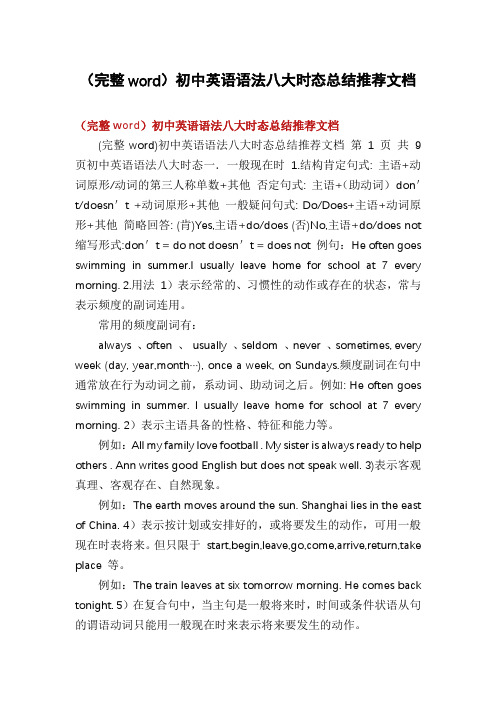
(完整word)初中英语语法八大时态总结推荐文档
(完整word)初中英语语法八大时态总结推荐文档
(完整word)初中英语语法八大时态总结推荐文档第1 页共9 页初中英语语法八大时态一.一般现在时 1.结构肯定句式: 主语+动词原形/动词的第三人称单数+其他否定句式: 主语+(助动词)don't/doesn't +动词原形+其他一般疑问句式: Do/Does+主语+动词原形+其他简略回答: (肯)Yes,主语+do/does (否)No,主语+do/does not 缩写形式:don't = do not doesn't = does not 例句:He often goes swimming in summer.I usually leave home for school at 7 every morning. 2.用法1)表示经常的、习惯性的动作或存在的状态,常与表示频度的副词连用。
常用的频度副词有:
always 、often 、usually 、seldom 、never 、sometimes, every week (day, year,month…), once a week, on Sundays.频度副词在句中通常放在行为动词之前,系动词、助动词之后。例如: He often goes swimming in summer. I usually leave home for school at 7 every morning. 2)表示主语具备的性格、特征和能力等。
例如:All my family love football . My sister is always ready to help others . Ann writes good English but does not speak well. 3)表示客观真理、客观存在、自然现象。
2024年初中英语语法八大时态总结过去将来时
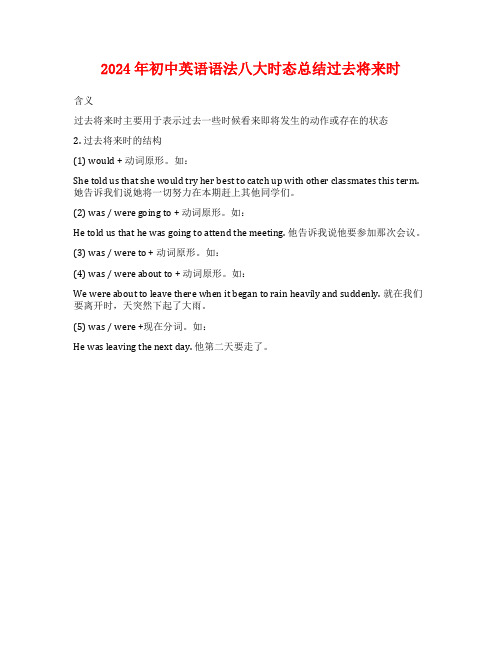
2024年初中英语语法八大时态总结过去将来时
含义
过去将来时主要用于表示过去一些时候看来即将发生的动作或存在的状态
2. 过去将来时的结构
(1) would + 动词原形。如:
She told us that she would try her best to catch up with other classmates this term. 她告诉我们说她将一切努力在本期赶上其他同学们。
(2) was / were going to + 动词原形。如:
He told us that he was going to attend the meeting. 他告诉我说他要参加那次会议。
(3) was / were to + 动词原形。如:
(4) was / were about to + 动词原形。如:
We were about to leave there when it began to rain heavily and suddenly. 就在我们要离开时,天突然下起了大雨。
(5) was / were +现在分词。如:
He was leaving the next day. 他第二天要走了。
初中八大时态教案
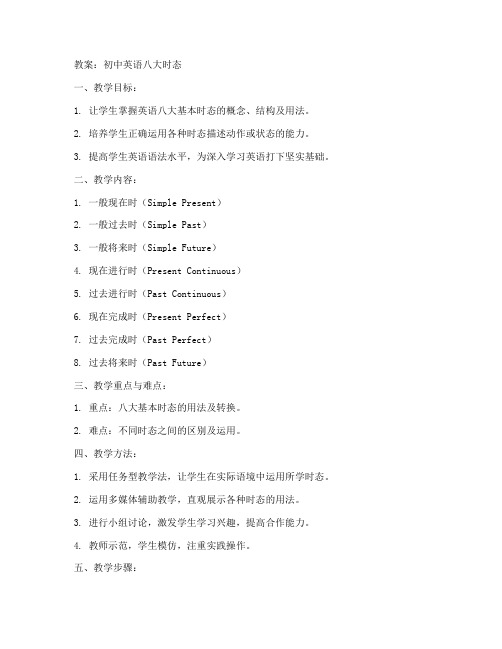
教案:初中英语八大时态
一、教学目标:
1. 让学生掌握英语八大基本时态的概念、结构及用法。
2. 培养学生正确运用各种时态描述动作或状态的能力。
3. 提高学生英语语法水平,为深入学习英语打下坚实基础。
二、教学内容:
1. 一般现在时(Simple Present)
2. 一般过去时(Simple Past)
3. 一般将来时(Simple Future)
4. 现在进行时(Present Continuous)
5. 过去进行时(Past Continuous)
6. 现在完成时(Present Perfect)
7. 过去完成时(Past Perfect)
8. 过去将来时(Past Future)
三、教学重点与难点:
1. 重点:八大基本时态的用法及转换。
2. 难点:不同时态之间的区别及运用。
四、教学方法:
1. 采用任务型教学法,让学生在实际语境中运用所学时态。
2. 运用多媒体辅助教学,直观展示各种时态的用法。
3. 进行小组讨论,激发学生学习兴趣,提高合作能力。
4. 教师示范,学生模仿,注重实践操作。
五、教学步骤:
1. 导入:简要介绍英语时态的概念及重要性。
2. 新课:讲解八大基本时态的概念、结构及用法。
3. 练习:进行各种时态的填空、改写句子等练习。
4. 小组讨论:分析不同时态在实际语境中的运用。
5. 总结:对比八大时态的区别,加深学生对时态的理解。
6. 作业:布置相关时态的练习题,巩固所学知识。
六、教学评价:
1. 课堂参与度:观察学生在课堂上的积极参与程度,了解学习兴趣。
2. 练习正确率:检查学生作业、测验等情况,了解掌握程度。
初中英语语法八大时态总结完整版初中英语时态总结
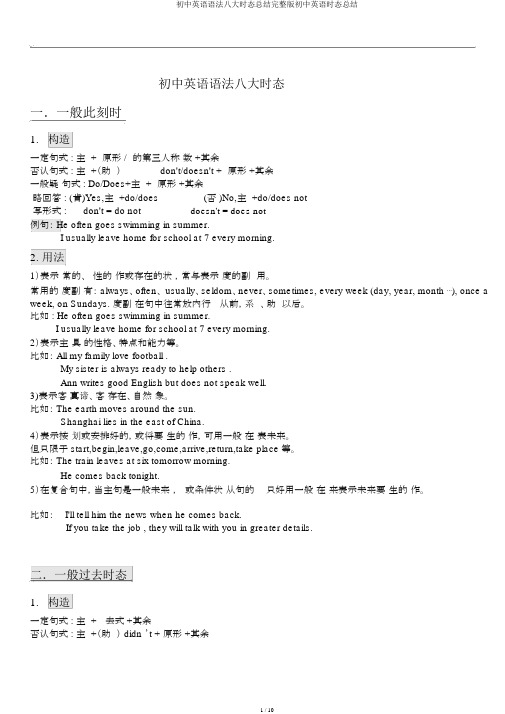
初中英语语法八大时态总结完整版初中英语时态总结
初中英语语法八大时态
一.一般此刻时
1.构造
一定句式 : 主 +原形 /的第三人称数 +其余
否认句式 : 主 +(助)don't/doesn't +原形 +其余
一般疑句式 : Do/Does+主 +原形 +其余
略回答 : (肯)Yes,主 +do/does(否 )No,主 +do/does not
写形式 : don't = do not doesn't = does not
例句: He often goes swimming in summer.
I usually leave home for school at 7 every morning.
2.用法
1)表示常的、性的作或存在的状,常与表示度的副用。
常用的度副有: always、often、 usually、seldom、never、sometimes, every week (day, year, month ⋯), once a week, on Sundays. 度副在句中往常放内行从前,系、助以后。
比如 : He often goes swimming in summer.
I usually leave home for school at 7 every morning.
2)表示主具的性格、特点和能力等。
比如: All my family love football .
My sister is always ready to help others .
Ann writes good English but does not speak well.
初中英语语法八大时态总结完整版
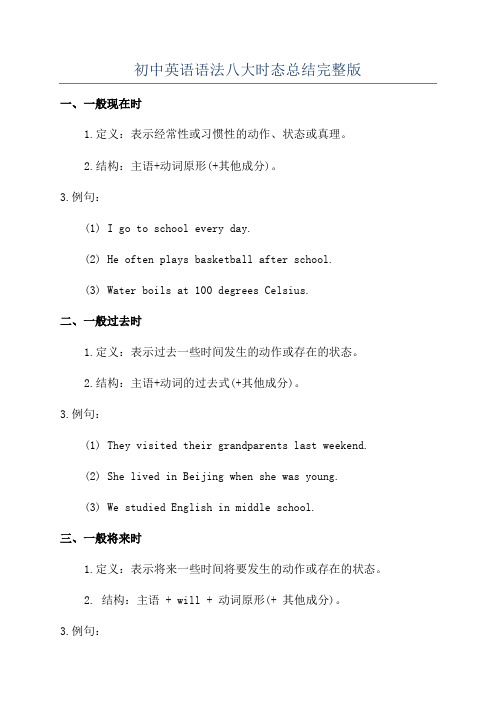
初中英语语法八大时态总结完整版
一、一般现在时
1.定义:表示经常性或习惯性的动作、状态或真理。
2.结构:主语+动词原形(+其他成分)。
3.例句:
(1) I go to school every day.
(2) He often plays basketball after school.
(3) Water boils at 100 degrees Celsius.
二、一般过去时
1.定义:表示过去一些时间发生的动作或存在的状态。
2.结构:主语+动词的过去式(+其他成分)。
3.例句:
(1) They visited their grandparents last weekend.
(2) She lived in Beijing when she was young.
(3) We studied English in middle school.
三、一般将来时
1.定义:表示将来一些时间将要发生的动作或存在的状态。
2. 结构:主语 + will + 动词原形(+ 其他成分)。
3.例句:
(1) I will go to the park tomorrow.
(3) We will have a party next week.
四、现在进行时
1.定义:表示现在正在进行的动作。
2. 结构:主语 + am/is/are + 动词-ing(+ 其他成分)。
3.例句:
(1) She is reading a book right now.
(2) They are playing soccer in the park.
初中英语语法八大时态总结(完整版)
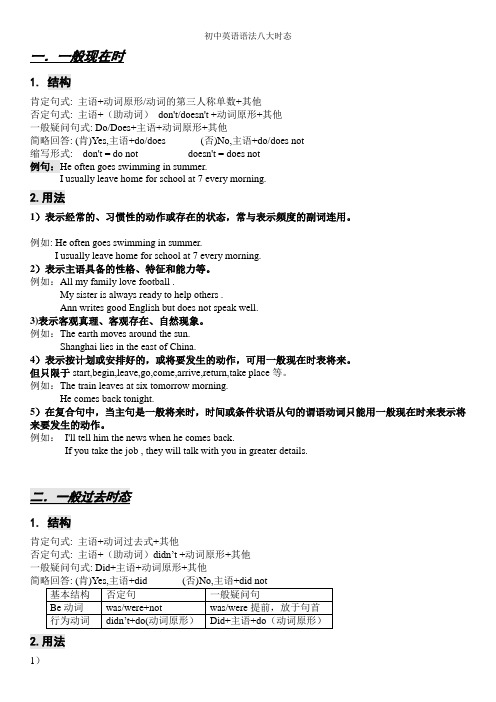
初中英语语法八大时态
一.一般现在时
1.结构
肯定句式: 主语+动词原形/动词的第三人称单数+其他
否定句式: 主语+(助动词)don't/doesn't +动词原形+其他
一般疑问句式: Do/Does+主语+动词原形+其他
简略回答: (肯)Yes,主语+do/does (否)No,主语+do/does not
缩写形式: don't = do not doesn't = does not
例句:He often goes swimming in summer.
I usually leave home for school at 7 every morning.
2.用法
1)表示经常的、习惯性的动作或存在的状态,常与表示频度的副词连用。
例如: He often goes swimming in summer.
I usually leave home for school at 7 every morning.
2)表示主语具备的性格、特征和能力等。
例如:All my family love football .
My sister is always ready to help others .
Ann writes good English but does not speak well.
3)表示客观真理、客观存在、自然现象。
例如:The earth moves around the sun.
Shanghai lies in the east of China.
4)表示按计划或安排好的,或将要发生的动作,可用一般现在时表将来。
初中英语语法八大时态总结(完整版)
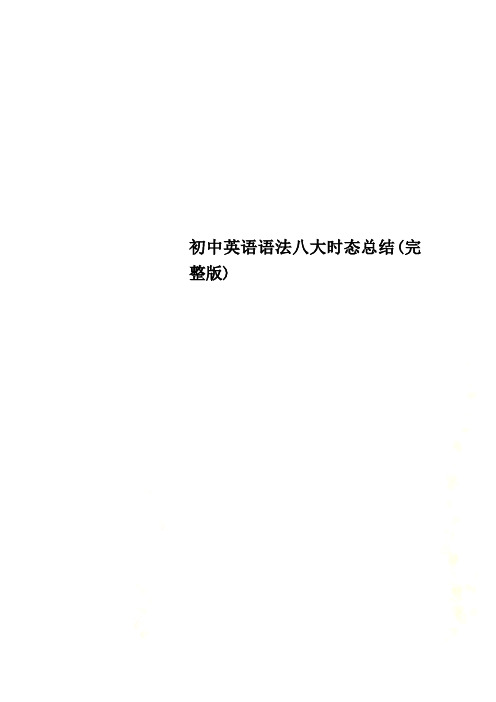
初中英语语法八大时态总结(完整版)
初中英语语法八大时态
一.一般现在时
1.结构
肯定句式: 主语+动词原形/动词的第三人称单数+其他
否定句式: 主语+(助动词)don't/doesn't +动词原形+其他
一般疑问句式: Do/Does+主语+动词原形+其他
简略回答: (肯)Yes,主语+do/does (否)No,主语+do/does not
缩写形式: don't = do not doesn't = does not
例句:He often goes swimming in summer.
I usually leave home for school at 7 every morning.
2.用法
1)表示经常的、习惯性的动作或存在的状态,常与表示频度的副词连用。
常用的频度副词有:always、often、usually、seldom、never、sometimes, every week (day, year, month…), once a week, on Sundays.频度副词在句中通常放在行为动词之前,系动词、助动词之后。例如: He often goes swimming in summer.
I usually leave home for school at 7 every morning.
2)表示主语具备的性格、特征和能力等。
例如:All my family love football .
My sister is always ready to help others .
初中英语语法八大时态总结
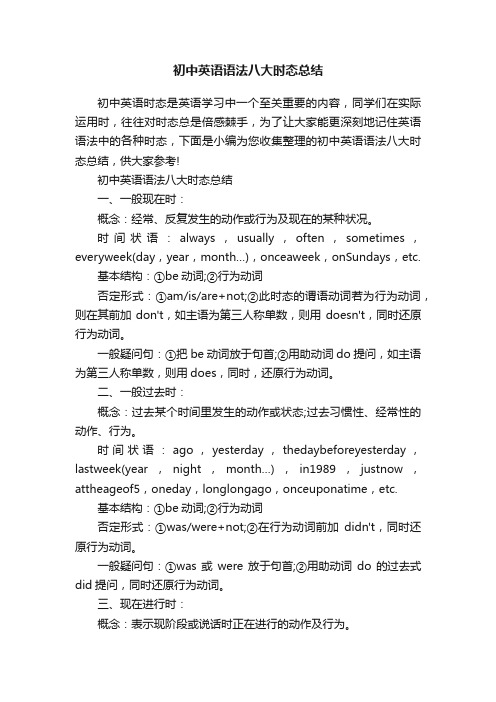
初中英语语法八大时态总结
初中英语时态是英语学习中一个至关重要的内容,同学们在实际运用时,往往对时态总是倍感棘手,为了让大家能更深刻地记住英语语法中的各种时态,下面是小编为您收集整理的初中英语语法八大时态总结,供大家参考!
初中英语语法八大时态总结
一、一般现在时:
概念:经常、反复发生的动作或行为及现在的某种状况。
时间状语:always,usually,often,sometimes,everyweek(day,year,month…),onceaweek,onSundays,etc.
基本结构:①be动词;②行为动词
否定形式:①am/is/are+not;②此时态的谓语动词若为行为动词,则在其前加don't,如主语为第三人称单数,则用doesn't,同时还原行为动词。
一般疑问句:①把be动词放于句首;②用助动词do提问,如主语为第三人称单数,则用does,同时,还原行为动词。
二、一般过去时:
概念:过去某个时间里发生的动作或状态;过去习惯性、经常性的动作、行为。
时间状语:ago,yesterday,thedaybeforeyesterday,lastweek(year,night,month…),in1989,justnow,attheageof5,oneday,longlongago,onceuponatime,etc.
基本结构:①be动词;②行为动词
否定形式:①was/were+not;②在行为动词前加didn't,同时还原行为动词。
一般疑问句:①was或were放于句首;②用助动词do的过去式did提问,同时还原行为动词。
(完整版)初中英语语法八大时态总结(完整版)
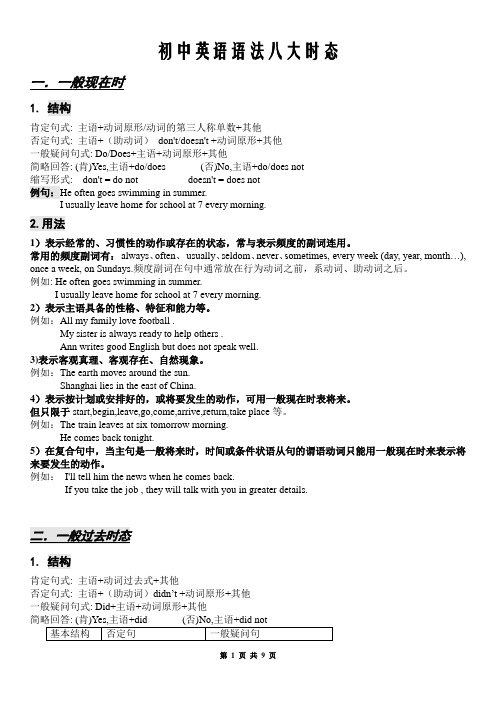
初中英语语法八大时态
一.一般现在时
1.结构
肯定句式: 主语+动词原形/动词的第三人称单数+其他
否定句式: 主语+(助动词)don't/doesn't +动词原形+其他
一般疑问句式: Do/Does+主语+动词原形+其他
简略回答: (肯)Yes,主语+do/does (否)No,主语+do/does not
缩写形式: don't = do not doesn't = does not
例句:He often goes swimming in summer.
I usually leave home for school at 7 every morning.
2.用法
1)表示经常的、习惯性的动作或存在的状态,常与表示频度的副词连用。
常用的频度副词有:always、often、usually、seldom、never、sometimes, every week (day, year, month…), once a week, on Sundays.频度副词在句中通常放在行为动词之前,系动词、助动词之后。
例如: He often goes swimming in summer.
I usually leave home for school at 7 every morning.
2)表示主语具备的性格、特征和能力等。
例如:All my family love football .
My sister is always ready to help others .
Ann writes good English but does not speak well.
初中八大时态总结归纳
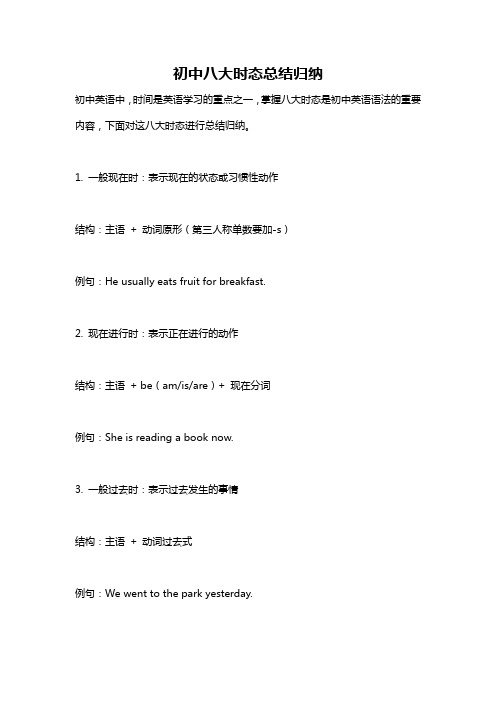
初中八大时态总结归纳
初中英语中,时间是英语学习的重点之一,掌握八大时态是初中英语语法的重要内容,下面对这八大时态进行总结归纳。
1. 一般现在时:表示现在的状态或习惯性动作
结构:主语+ 动词原形(第三人称单数要加-s)
例句:He usually eats fruit for breakfast.
2. 现在进行时:表示正在进行的动作
结构:主语+ be(am/is/are)+ 现在分词
例句:She is reading a book now.
3. 一般过去时:表示过去发生的事情
结构:主语+ 动词过去式
例句:We went to the park yesterday.
4. 过去进行时:表示过去某个时间正在进行的动作
结构:主语+ was/were + 现在分词
例句:I was watching TV when he called.
5. 将来时:表示将要发生的事情
结构:主语+ will/shall + 动词原形
例句:They will visit Japan next month.
6. 现在完成时:表示过去某个时间开始并持续到现在的动作已完成结构:主语+ have/has + 过去分词
例句:I have finished my homework.
7. 过去完成时:表示过去的某个时间已经完成的动作
结构:主语+ had + 过去分词
例句:He had already left when I arrived.
8. 将来完成时:表示将来某个时间将会完成的动作
结构:主语+ will/shall + have + 过去分词
初中英语语法八大时态总结(完整版)
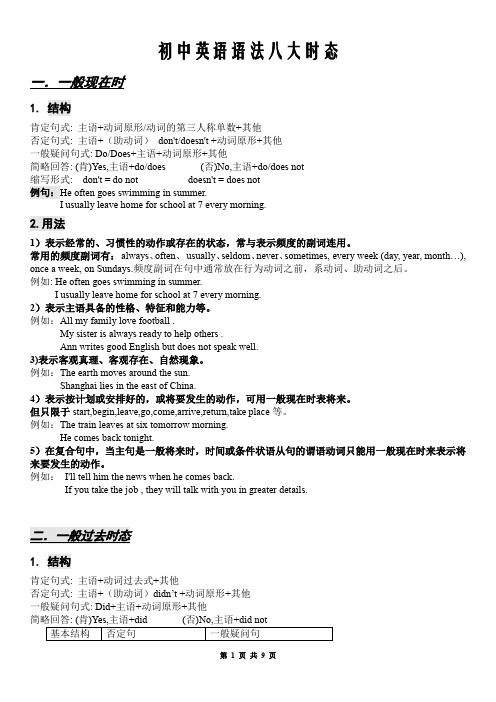
初中英语语法八大时态
一.一般现在时
1.结构
肯定句式: 主语+动词原形/动词的第三人称单数+其他
否定句式: 主语+(助动词)don't/doesn't +动词原形+其他
一般疑问句式: Do/Does+主语+动词原形+其他
简略回答: (肯)Yes,主语+do/does (否)No,主语+do/does not
缩写形式: don't = do not doesn't = does not
例句:He often goes swimming in summer.
I usually leave home for school at 7 every morning.
2.用法
1)表示经常的、习惯性的动作或存在的状态,常与表示频度的副词连用。
常用的频度副词有:always、often、usually、seldom、never、sometimes, every week (day, year, month…), once a week, on Sundays.频度副词在句中通常放在行为动词之前,系动词、助动词之后。
例如: He often goes swimming in summer.
I usually leave home for school at 7 every morning.
2)表示主语具备的性格、特征和能力等。
例如:All my family love football .
My sister is always ready to help others .
Ann writes good English but does not speak well.
初中英语语法八大时态精讲总结
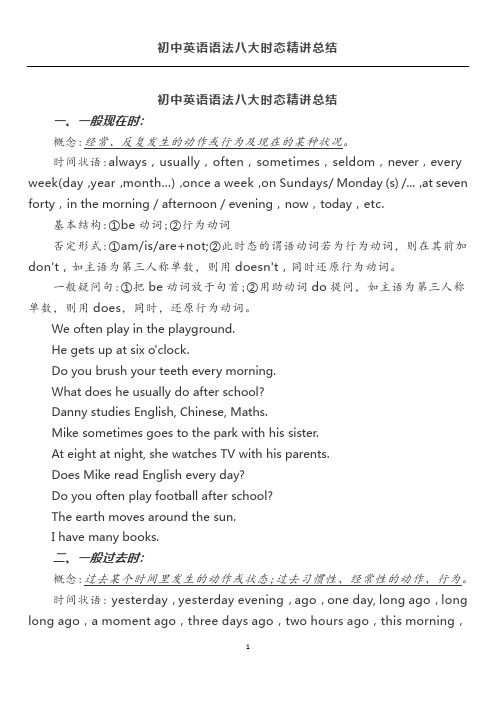
初中英语语法八大时态精讲总结
一、一般现在时:
概念:经常、反复发生的动作或行为及现在的某种状况。
时间状语:always,usually,often,sometimes,seldom,never,every week(day,year,month…),once a week,on Sundays/ Monday (s) /...,at seven forty,in the morning / afternoon / evening,now,today,etc.
基本结构:①be动词;②行为动词
否定形式:①am/is/are+not;②此时态的谓语动词若为行为动词,则在其前加don't,如主语为第三人称单数,则用doesn't,同时还原行为动词。
一般疑问句:①把be动词放于句首;②用助动词do提问,如主语为第三人称单数,则用does,同时,还原行为动词。
We often play in the playground.
He gets up at six o'clock.
Do you brush your teeth every morning.
What does he usually do after school?
Danny studies English, Chinese, Maths.
Mike sometimes goes to the park with his sister.
At eight at night, she watches TV with his parents.
Does Mike read English every day?
- 1、下载文档前请自行甄别文档内容的完整性,平台不提供额外的编辑、内容补充、找答案等附加服务。
- 2、"仅部分预览"的文档,不可在线预览部分如存在完整性等问题,可反馈申请退款(可完整预览的文档不适用该条件!)。
- 3、如文档侵犯您的权益,请联系客服反馈,我们会尽快为您处理(人工客服工作时间:9:00-18:30)。
初中英语语法八大时
态总结
初中英语语法八大时态
1.结构
肯定句式: 主语+动词原形/动词的第三人称单数+其他
否定句式: 主语+(助动词) don't/doesn't +动词原形+其他
一般疑问句式: Do/Does+主语+动词原形+其他
简略回答: (肯)Yes,主语+do/does (否)No,主语+do/does not
缩写形式: don't = do not doesn't = does not
例句:He often goes swimming in summer.
I usually leave home for school at 7 every morning.
2.用法
1)表示经常的、习惯性的动作或存在的状态,常与表示频度的副词连用。
常用的频度副词有:always、often、 usually、seldom、never、sometimes, every week (day, year, month…), once a week, on Sundays.频度副词在句中通常放在行为动词之前,系动词、助动词之后。例如: He often goes swimming in summer.
I usually leave home for school at 7 every morning.
2)表示主语具备的性格、特征和能力等。
例如:All my family love football .
My sister is always ready to help others .
Ann writes good English but does not speak well.
3)表示客观真理、客观存在、自然现象。
例如:The earth moves around the sun.
Shanghai lies in the east of China.
4)表示按计划或安排好的,或将要发生的动作,可用一般现在时表将来。
但只限于start,begin,leave,go,come,arrive,return,take place等。
例如:The train leaves at six tomorrow morning.
He comes back tonight.
5)在复合句中,当主句是一般将来时,时间或条件状语从句的谓语动词只能用一般现在时来表示将来要发生的动作。
例如: I'll tell him the news when he comes back.
If you take the job , they will talk with you in greater details.
1.结构
肯定句式: 主语+动词过去式+其他
否定句式: 主语+(助动词)didn’t +动词原形+其他
一般疑问句式: Did+主语+动词原形+其他
简略回答: (肯)Yes,主语+did (否)No,主语+did not
2.用法
1)表示过去某一时刻或某一段时间里所发生的动作或情况。常和表示过去的时间状语yesterday, just now, the other day, in 1982, ago, an hour ago, long long ago, the day before yesterday, last
week(year, night, month…), at the age of 5, one day, once upon a time等连用
例如:Where did you go just now?
After a few years, she started to play the piano.
2)表示在过去,经常或反复发生的动作。常与often,always等表示频度的副词连用。
例如:When I was a child, I often played football in the street.
我是个孩子的时候,常在马路上踢足球。
3)一般过去式也可与today,this week,this month,this year等表现在的时间状语连用,但这些时间状语须指过去的时间,决不包含“现在”“此时此刻”的意思。
例如:Did you see him today?今天你看见他了吗?
1.结构
结构1:
肯定句式:主语+助动词will+动词原形+其他
否定句式:主语+助动词will+动词原形+not+其他
一般疑问句式:助动词Will+主语+动词原形+其他
简单回答:在口语中,will在名词或代词后常缩为’ll,wii not常简缩为won’t。
在疑问句中,主语为第一人称时(I和we)时,常用助动词shall。
例如:She’ll go to play basketball.
Shall we go to the zoo?
结构2:
肯定句式:主语+be going to +动词原形+其他
否定句式:主语+be not going to +动词原形+其他
一般疑问句式:Be+主语+going to+动词原形+其他
简略回答:(肯)Yes,主语+be (否)No,主语+be not
2.用法
1)表示将来某个时间要发生的动作或存在的状态,常与tomorrow, next day(week, month, year…), soon, in a few minutes, by…, the day after tomorrow等连用。
例如:I'll meet you at the school gate tomorrow morning.
2)、表示说话人对于将来的看法、假设和推测,通常用于be afraid, be/feel sure, hope, know, think 等后面的从句或与副词perhaps,possibly,maybe等连用。
例如:I think she’ll go back home for supper.
Maybe she’ll go to the gym.
将来时其他表示法
1)be going to表示将来
